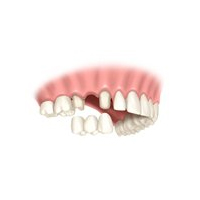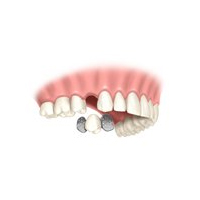What Is A Bridge?

A bridge is a device used to replace missing teeth. A bridge attaches artificial teeth (pontics) to adjacent teeth called abutment teeth. Fixed bridges are applied by either placing crowns on the abutment teeth or by bonding the artificial teeth directly to the abutment teeth.
Why Do I Need A Bridge?
All your teeth play an important role in your appearance, in speech, chewing and in maintaining proper alignment of other teeth. Teeth are designed to compliment each other. Unusual forces and stresses are placed on neighboring teeth when a tooth is lost causing a number of potentially harmful disorders including:
- Adjacent teeth drifting and shifting
- Teeth in the opposing dental arch moving out of its socket (over eruption)
- Acceleration of periodontal (gum) disease
- Potential food traps
- Increased risk of decay
- Further loss of tooth space
- Jaw joint degeneration (TMJ)
- Jaw muscle problems
If the missing tooth is not replaced, more teeth will eventually be lost due to improper forces exerted during chewing. The loss of a back tooth may cause your mouth to sink and your face to look older.
Who should get a bridge?
If you are missing any teeth and are committed to maintaining good oral hygiene practices, you may be a good candidate for a bridge. This space caused by missing tooth can cause the surrounding teeth to drift out of position and can cause teeth and gums to become more susceptible to tooth decay and gum disease that can cause further tooth loss. Fixed bridges not only correct an altered bite, improve your chewing ability and speech, but they also safeguard your appearance by preventing the collapse of your facial features that can cause premature wrinkles and age lines.
What types of bridges are there?

Besides traditional bridges, another popular design is the resin bonded or " Maryland " bridge, primarily used for the front teeth. This is usually the most economical choice when the abutment teeth are healthy and don't contain large fillings. The pontic is fused to metal bands that can be bonded to the abutment teeth with resin cement and hidden from view, reducing the amount of preparation on the adjacent teeth.
What procedures are involved?
For a traditional fixed bridge, the first appointment consists of the dentist reducing the adjacent abutment teeth that will act as anchors. Impressions are made, from which a metal framework, including the pontic, is created. By the second appointment, the final bridge is fitted over the teeth.
The total treatment time is usually between two and four weeks, depending on the type of bridge.
How do I care for a bridge?
With a bridge, it is more important than ever to brush, floss and see your dentist regularly. If you do not control the build-up of food debris and plaque - the sticky film of bacteria formed from acids in foods - your teeth and gums can become infected, requiring further treatment and resulting in possible loss of the bridge. Your dentist may also recommend using floss threaders that help remove bacteria from hard to reach spaces between the bridge and adjacent teeth and gums.
If you maintain optimal oral hygiene care, you can expect your fixed bridge to last as many as 8-10 years, or even longer.
What Are The Benefits Of Bridgework?
Bridge treatment reverses the negative of missing teeth in a variety of ways:
- Restores and maintains the natural bite
- Prevents unnatural stresses on other teeth
- Keeps opposing teeth in their proper place
- Prevents shifting and drifting of adjacent teeth
- Discourages further dental decay and periodontal disease
- Enhances your smile, speech and chewing function
- Bridgework is a long-term solution to replace lost teeth, support remaining teeth and help you maintain optimum dental health



